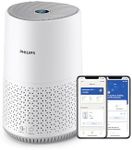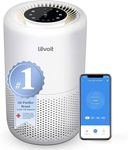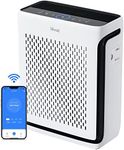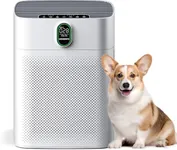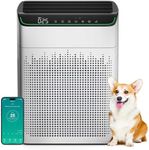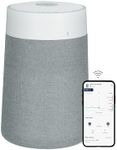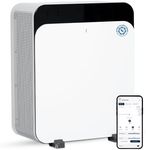Buying Guide for the Best Air Purifier For Cats
Choosing the right air purifier for your home, especially if you have cats, is essential for maintaining a clean and healthy environment. Cats can contribute to indoor air pollution through dander, fur, and litter box odors. An air purifier can help reduce these pollutants, making the air cleaner and more breathable for both you and your feline friends. Here are some key specifications to consider when selecting an air purifier for a home with cats.HEPA FilterA HEPA (High-Efficiency Particulate Air) filter is crucial for capturing tiny particles like pet dander, dust, and other allergens. This type of filter can trap particles as small as 0.3 microns with 99.97% efficiency. For homes with cats, a HEPA filter is essential to ensure that the air purifier effectively removes the fine dander and fur that cats shed. Look for air purifiers that specifically mention having a true HEPA filter for the best results.
Activated Carbon FilterAn activated carbon filter is important for removing odors, including those from cat litter boxes and general pet smells. This filter works by adsorbing gases and odors onto a bed of activated carbon. When choosing an air purifier, consider the size of the activated carbon filter and its capacity to handle pet odors. Larger or more substantial carbon filters will generally be more effective at controlling strong or persistent smells.
CADR (Clean Air Delivery Rate)CADR measures the volume of air an air purifier can clean of specific particles (like smoke, pollen, and dust) per minute. Higher CADR ratings indicate a more efficient air purifier. For homes with cats, a higher CADR for dust and pollen is beneficial, as it indicates the purifier can quickly and effectively remove pet dander and other allergens. Choose a model with a CADR rating that matches the size of the room where the air purifier will be used.
Noise LevelNoise level is an important consideration, especially if the air purifier will be used in a bedroom or living area. Air purifiers can produce varying levels of noise, measured in decibels (dB). Quieter models, typically under 50 dB, are preferable for maintaining a peaceful environment. If you or your cats are sensitive to noise, look for air purifiers with a 'sleep mode' or adjustable fan speeds to reduce noise levels during operation.
Room Size CoverageRoom size coverage indicates the maximum area an air purifier can effectively clean. This is usually measured in square feet. To ensure optimal performance, choose an air purifier that matches or exceeds the size of the room where it will be used. For example, if you have a large living room, select a model designed for larger spaces to ensure it can handle the volume of air and effectively remove pollutants.
Filter Replacement and MaintenanceRegular maintenance and filter replacement are necessary to keep an air purifier functioning effectively. Check the recommended replacement intervals for the filters and consider the cost and availability of replacement filters. Some models have indicators that alert you when it's time to change the filter, which can be very convenient. Choose an air purifier with easily accessible and replaceable filters to ensure you can maintain it without hassle.
Additional FeaturesAdditional features such as air quality sensors, automatic mode, and smart connectivity can enhance the functionality of an air purifier. Air quality sensors can adjust the purifier's settings based on the detected air quality, ensuring optimal performance. Smart connectivity allows you to control the purifier remotely via a smartphone app. Consider which additional features are important to you and how they can improve your experience with the air purifier.
